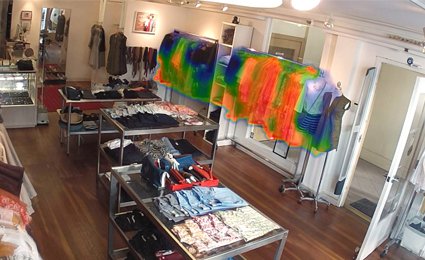
Surveillance cameras are becoming a whole lot smarter as businesses use video data to drive decision making.
It’s getting harder to go anywhere where there’s not a mounted camera (even in people’s homes). They’re becoming so ubiquitous that shoppers hardly notice them …especially during the busy holidays.
But businesses are starting to take great notice, and realizing there’s more value from a security or surveillance camera than just a live view of shoppers.
It’s the intelligence in the video that’s helping companies stay competitive.
Decisions Based on Data
"In the past, merchandising decisions typically have been made based on a merchant’s gut feeling. There’s now a way to make them based on data," says Steve Russell, CEO and founder of Prism Skylabs, a San Francisco-based video analytics company. Adds Russell, "Retail is very much an in-person business. Many store employees make decisions based on what they see. They develop incredible intuitions. With data, retailers can validate those intuitions and make smarter decisions."
Prism Skylabs combines security camera video with software to build ‘path maps’ of people’s movements (where they first go when entering a store) and ‘heat maps’ that use hot colors (like red and orange) to denote how long a customer has stood in front of an item, or how many times the item has been handled.
(Prism says it uses privacy protection that ‘removes’ people from video before it’s viewed.)
Russell says video also allows companies to ?peek’ into a store anytime, anywhere to see if the ?brand concept’ (a store look) is being followed consistently.
Video cameras have been creeping into commerce for years, telling us where people are walking, pausing, if the lines are too long at a checkout counter, and if people are walking away. But it would take an army of staffers to view hours of recorded data, and only sophisticated algorithms can derive real intelligence from video.
Real-Time Business Insights
MachineShop is a next-generation middleware company based in Boston and Denver that helps companies bridge the gap between actual operational technology (OT) and information systems.
CTO Greg Jones says real-time data from security cameras is often synched with other systems like a point of sale system.
For example, if lower sales or missing receipts coincide when cameras weren’t functioning, were they turned off intentionally?
The next time the camera turns off, a message goes out to the security team. Jones says customers want the bigger picture, and to pull in information and connect services from many devices.
Jones says one of its customers, Diebold Inc., an Ohio-based electronic security systems company (that also makes many of the ATM cash machines we see) wanted to create one, integrated view of their security environment for their financial and commercial customers.
Says Jones, “Our job was to extract the complexity of communications from all their devices ? including video, alarms and card readers ? and turn it into a language they could understand (APIs).”
Jeremy Brecher is Diebold’s VP of Technology, Electronic Security. “You can install devices or cameras on the network but you want to drive additional value out of those investments.”
He says Diebold’s SecureStat security management portal gives its customers an integrated view of device status and event history, while bringing in external data such as local weather alerts.
Says Brecher, “Think about weather. If we have retail locations experiencing frequent power outages, and overlay that information with weather data, we can figure out what’s happening, and what may be coming next. Then we can actively monitor these locations, notify our customers, and help them manage the situation.”
He adds that, business-wise, video data can tell you an extraordinary amount about how efficiently a location runs, and why one location may be doing better than another.
“Every day, someone comes in and opens and closes a bank location. Every day, there’s movement recorded on video ? people going in and out of doors. Video is stored and we’re looking for that anomaly. Hmm, a branch closed late. Why?”
And what about all of those Diebold ATMs? How is video used to protect all that money?
“A fair amount of crime is high tech or malware based, but there’s still a lot of low tech crime that takes place, like a pickup truck pulling an ATM machine out of the ground and dragging it away,” says Brecher.
He says in high crime areas, some of Diebold’s customers use active GPS trackers on ATMs that can notify a monitoring center and let police know the location of a stolen ATM.
“Of course, there are also criminals who try to blow up an ATM. Even in these situations, traditional alarm devices and cameras are still very effective.”
Blowing stuff up seems pretty old fashioned these days. But how businesses are using real-time, intelligent data from video is today’s new business model.
“It’s a win-win,” says Prism’s Russell. “Retailers can ensure their stores are well stocked, well staffed, and always on brand. And customers get to enjoy a better shopping experience.”
Source: cisco.com
